STANLEY KUBRICK'S Full Metal Jacket
Shot-by-Shot Analysis
Part Four
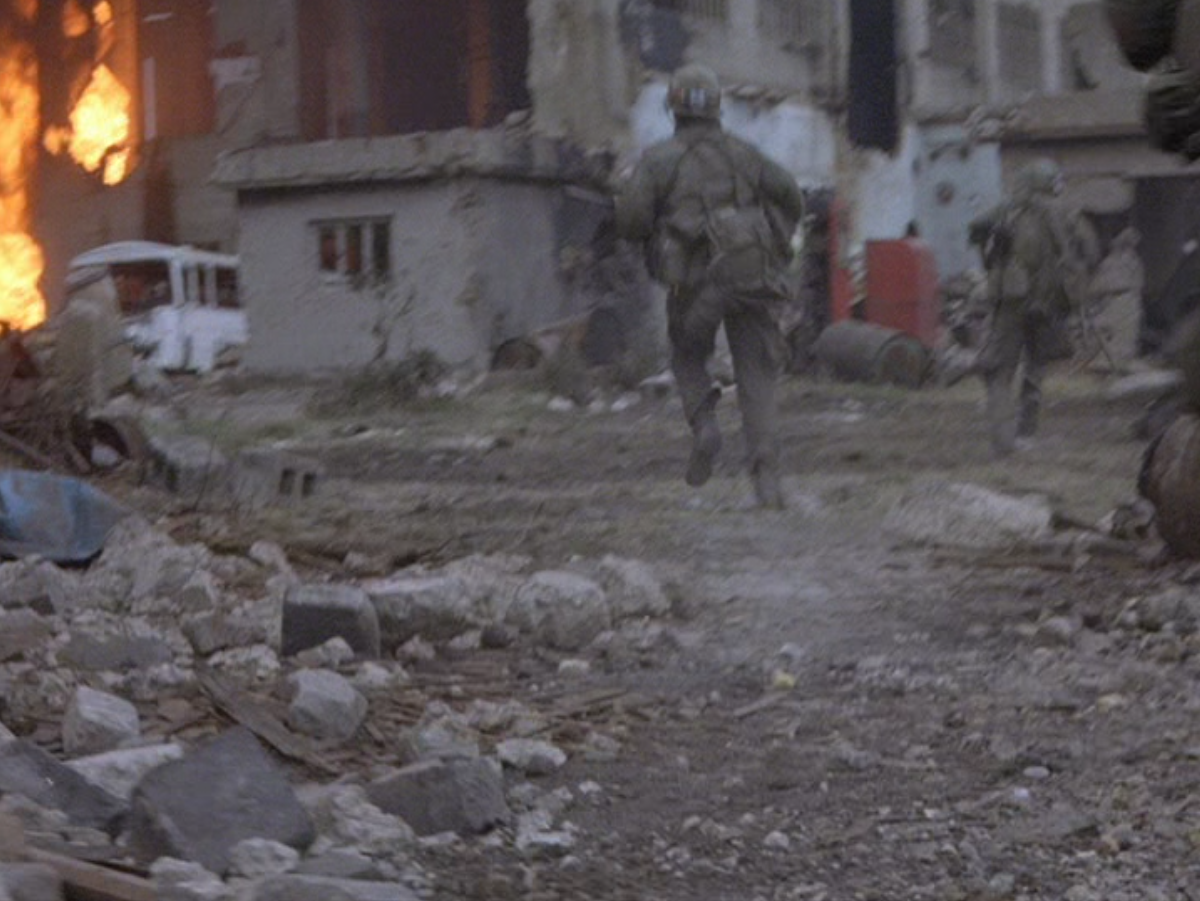
Go to TOC for this film ( (which has also a statement on purpose and manner of analysis and a disclaimer as to caveat emptor and my knowing anything authoritatively, which I do not, but I do try to not know earnestly, with some discretion, and considerable thought).
TOC and Supplemental Posts | Part 1 | Part 2 | Part 3 | Part 4 | Part 5 | Part 6 | Part 7 | Part 8 | Films Home
LINKS TO SECTIONS OF THE ANALYSIS ON THIS PAGE:
Reunion with Cowboy / The Birthday Celebration, Shots 318 through 344
The Death of Touchdown / Two Confirmed Kills, Shots 345 through 391
318 Crossfade to Rafter Man and Joker walking through a field, smoke beyond. (1:05:15)
319 Crossfade to Rafter Man and Joker arriving at Hotel Two-Five. Begin "Wooly Bully". (1:05:35)
JOKER: Hey, bro. We're looking for 1st Platoon, Hotel Two-Five.
MARINE:
Around the back.
JOKER: First Platoon?
MARINE: Yeah, through there.
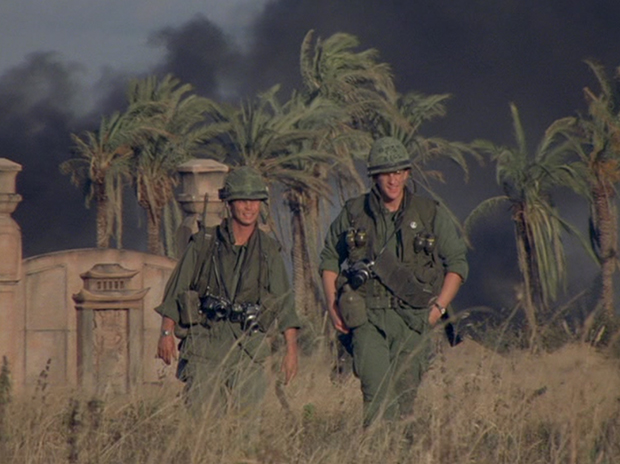 318 |
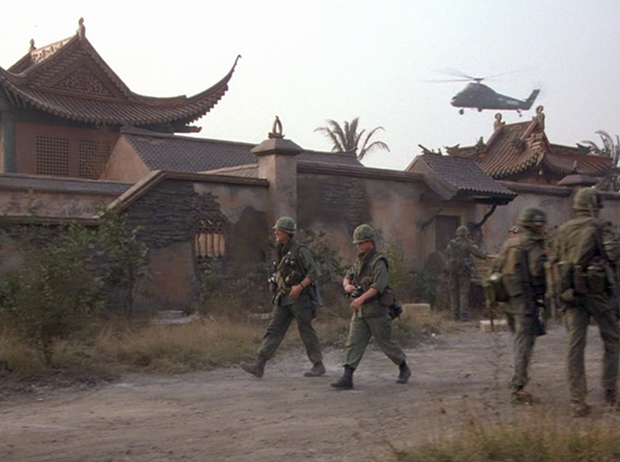 319 |
320 MLS through a circular doorway of Cowboy standing before a mirror shaving. We can see Joker and Rafter Man through another circular doorway beyond advancing. Zoom in. As Joker finishes and puts on his glasses Joker addresses him. (1:05:46)
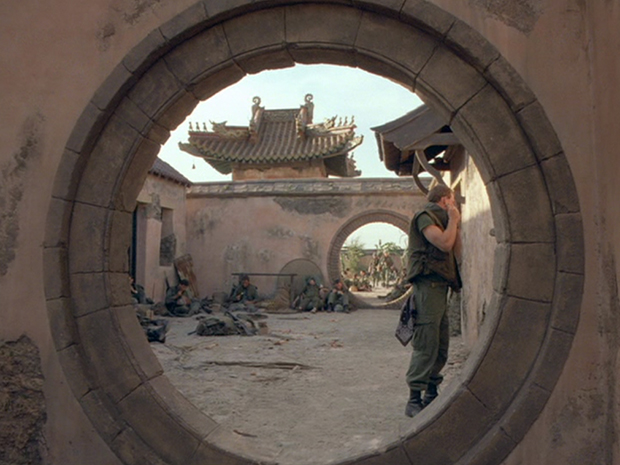
JOKER: Hey, Lone Ranger.
COWBOY: Holy shit. It's the Joker.
JOKER (they hug): You old motherfucker.
JOKER:
What's happening?
COWBOY:
Thought I hoped I'd never see you again, you piece of shit. (They hug again.)
JOKER:
What's happening, man?
COWBOY:
Oh, just waiting to get back to the land of the big PX.
JOKER:
Yeah? Well, why go back? Here or there, samey-same.
321 MS of Cowboy and Joker from the other side. (1:06:35)

COWBOY: Been getting any?
JOKER: Only your sister.
COWBOY:
Well, better my sister than my mom, though my mom's not bad.
Hey, you Hogs, listen up. This is my bro, Joker, from the Island, and this is...?
JOKER: Rafter Man.
COWBOY: Rafter Man.
They're from Stars and Stripes. They'll make you famous.
322 MS of Rodriguez and Animal Mother. (1:06:55)
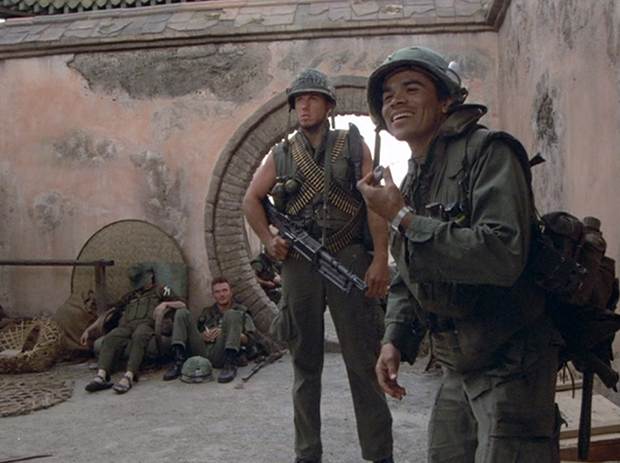
T.H.E. ROCK: Fucking A.
COWBOY (off screen): We're the Lusthog Squad. We're life-takers and heartbreakers. We shoot them full of holes and fill them full of lead.
ANIMAL MOTHER (advancing):
You a photographer?
323 MCU of Joker from beyond Mother Animal's left. (1:07:15)
JOKER: No, I'm a combat correspondent.
324 MCU of Joker and Animal Mother, profile. (1:07:19)
ANIMAL MOTHER:
Oh, you seen much combat?
Laughter.
JOKER:
Well, I've seen a little on TV.
More laughter.
325 MCU of Animal Mother from beyond Joker's right shoulder. (1:07:26)
ANIMAL MOTHER: You're a real comedian.
326 MCU of Joker from beyond Animal Mother's left shoulder. (1:07:32)
JOKER: Well, they call me the Joker.
327 Animal Mother as in shot 325. (1:07:37)
ANIMAL MOTHER:
Well, I got a joke for you. I'm gonna tear you a new asshole.
MARINES: Whoa!
328 MCU side view of Joker and Animal Mother with Rafter Man beyond. (1:07:45)
JOKER (mimicking John Wayne): Well, pilgrim, only after you eat the peanuts out of my shit.
329 MCU of Animal Mother from beyond Joker's right shoulder. (1:07:54)
ANIMAL MOTHER:
You talk the talk.
Do you walk the walk?
MARINES: Oh...
330 MCU of Cowboy, Joker, Animal Mother and Rafter Man from the side. Cowboy has grasped Joker to keep him from hitting Animal Mother. Eightball approaches to restrain Animal Mother. (1:08:06)
EIGHTBALL (intervening): Now, you might not believe it...
331 MCU of Eightball standing between Joker and Animal Mother. (1:08:10)
EIGHTBALL: ...but under fire, Animal Mother's one of the finest human beings in the world. All he needs is somebody to throw hand grenades at him the rest of his life.
332 MS side view as Eightball steps away, Animal Mother standing back, and Cowboy pulling back on Joker. (1:08:20)
COWBOY: That's a roger, come on. Sit down. Come on, new guy.
 323 |
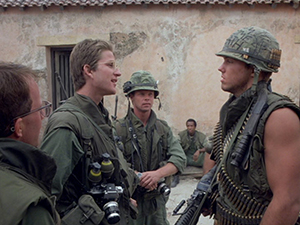 324 |
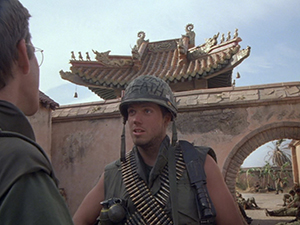 325 |
 326 |
 327 |
 328 |
 329 |
 330 |
 331 |
 332 |
333 MCU of Eightball and Animal Mother taking a seat before a wall. (1:08:26)
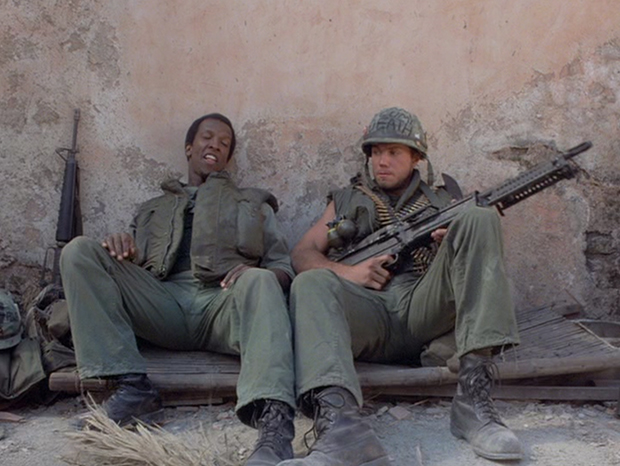
ANIMAL MOTHER:
Hey, jungle-bunny. Thank God for the sickle cell, huh?
EIGHTBALL:
Yeah, Mother.
334 MCU of Crazy Earl against a wall sitting beside what will be revealed as a dead NVA. (1:08:26)

CRAZY EARL: Hey, photographer.
335 MS 3/4 view of Rafter Man, Joker and Cowboy leaning against the shaving shelf wall. Rafter Man, taking photos, looks over at Crazy Earl. (1:08:39)
CRAZY EARL: You wanna take a good picture?
336 Crazy Earl as in shot 334. (1:08:42)
CRAZY EARL: Here, man. Take this. (Waving over Rafter Man.)
337 Rafter Man as in shot 335, rising. (1:08:47)
338 MCU Crazy Earl gesturing for Rafter Man to be quiet (1:08:52)
CRAZY EARL: This is my bro.
339 MCU of Rafter Man looking into the camera, preparing to take photos. (1:09:00)
340 Crazy Earl as in 338, removing the hat off the dead man's face. (1:09:02)
CRAZY EARL: This is his party. He's the guest of honor. Today is his birthday.
341 MCU of Animal Mother and Eightball from their left. (1:09:15)
ANIMAL MOTHER:
Happy birthday, zipperhead.
The Marines laugh.
342 Crazy Earl as in 340. (1:09:18)
CRAZY EARL: I will never forget this day--the day I came to Hue City and fought 1 million NVA gooks. I love the little commie bastards, man, I really do. These enemy grunts are as hard...
343 MCU of Rafter Man looking into the camera, taking photos. (1:09:32)
CRAZY EARL (off screen): as slant-eyed drill instructors.
344 Crazy Earl as in 342. (1:09:36)
CRAZY EARL: These are great days we're living, bros. We are jolly green giants, walking the earth with guns. These people we wasted here today are the finest human beings we will ever know. After we rotate back to the world, we're gonna miss not having anyone around who's worth shooting.
 335 |
 336 |
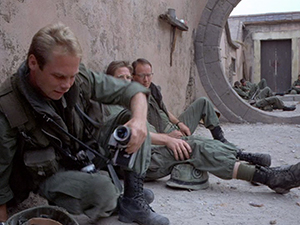 337 |
 338 |
 339 |
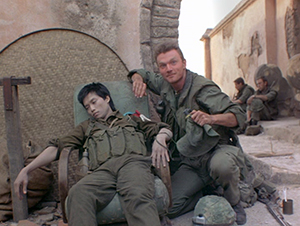 340 |
 341 |
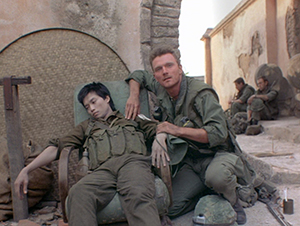 342 |
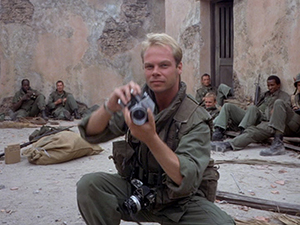 343 |
 344 |
Much is sacrificed of The Short-timers in its translation to the screen, but what the film, as a visual medium, does communicate, at least to a certain extent, is a sense of the radical environmental/cultural disorientation that could happen with a Marine, especially one of the many who had never left their home city/town until boot camp. Boot camp was the first big culture shock for 18 and 19-year-olds for whom this was also their first extended time away from family and friends, but it was still America (though those from the north who went to boot camp in Parris Island often state they felt as though they were in a foreign country). What Kubrick showed us following boot camp was a a market corner in Da Nang, and though it certainly isn't America it is a place partly tailored for serving Americans, the drinks of the bar before which Joker and Rafter sit listed on the wall in English. Then Joker and Rafter Man return to where they live, which is the base, and that has a very American atmosphere--and was presented rather too nicely as Gustav wrote of being unsettled by, every night, the hordes of rats that would emerge when the lights went out, and is something I've heard over and over again in interviews. Michael Herr also writes of this in Dispatches. After a helicopter trip to where Joker and Rafter Man view the victims of a massacre, Kubrick shows Joker locating Cowboy in a villa of traditional Vietnamese architecture, which he perhaps trusts will set a number of viewers back a moment as they adjust to elements that are typically alien to western architecture--such as the round doors. Rectangular doors are normal in traditional Vietnamese architecture, but his use of these round courtyard doors, Moon gates (which also complement it being the Lunar New Year), are, in the film, a threshold to a very new world for western viewers. It is also a very old world, one with a deep and complex history and culture about which most Americans know nothing. Those who are even unaware of that history, and know nothing about the culture, will still feel that deep history with the artistry displayed in the building's architecture, and a part of our disorientation is that it is filled not with Vietnamese but American Marines sitting around resting and waiting. Indeed, the only Vietnamese we see in the building is a dead soldier of the NVA (North Vietnamese Army).
All this may seem very simplistic to treat as a topic, but the America of the 21st century is not mid-20th century America where even Asian food might be considered exotic, and images of real life in other countries was not easily accessible on the internet, though certainly one might be familiar with other lifestyles through a variety of means.
I remember when I saw Full Metal Jacket in the theater, when it first came out, and on the big screen those round lunar doors gave the feeling of a major transition through Kubrick's timing and editing and the zoom in on the door.
Kubrick is also, as I related in Part Three of my analysis, taking us into the underworld.
Joker is looking for Hotel 2-5. What is Hotel 2-5? Hotel Company is one of the four companies (Echo, Fox, Golf, and Hotel) of the 2nd Battalion, an infantry battalion, of the 5th Marine Regiment and the 1st Marine Division. According to the Marines website, a fire team has 3 individuals, a squad has 9 and is commanded by a sergeant, a platoon has 3 squads (27 people) and is commanded by a lieutenant, a company has 3 platoons (243 people) and is commanded by a captain (this makes me nervous that we're going by the rule of 3 here and a platoon has 27 people and a company has 3 platoons but is given as having 243 people), a battalion is composed of 3 companies (729 people) and is commanded by a lieutenant colonel, a regiment is composed of 3 battalions (2187 people) and is commanded by a colonel, a marine division is composed of 3 regiments (6561 people) and is commanded by a major general, the Marine Corps is composed of 4 Marine divisions and is commanded by the commandant. 2-5 was, according to Wikipedia, deployed to Vietnam from April 1966 to 1971 and was at Hue, Que Son, Phu Bai, Dong Ha, and Phu Loc.
The way the war correspondents worked is, assigned to a division, they would be assigned to cover infantry in different operations, and were floaters, able to choose which unit to hook up with. Hasford was with the 1st Marine Division combat correspondents serving in "I Corps" which served the northernmost region in South Vietnam. We can comprehend some of this from conversations in the film but there is a certain expectation of the audience to have knowledge of how the military works, and also the Tet Offensive, or the determination is that it doesn't much matter if they do because that knowledge isn't critical and this is a fictional representation that takes liberties.
In the novel, the unit Joker hooked up with was instead Delta Company, 1st Battalion, Fifth Marine Regiment, FIrst Marine Division, deployed, according to Wikipedia, to Vietnam from June 1966 to March 1971, in action around Chu Lai, Danang, Quang Nam, Que Son Valley, Hoi An, Phu Loc, and An Hoa.
In the film, Cowboy is with 2-5 rather than 1-5. This may have to do with areas of Hue where engagement takes place in the film, striving toward some believability concerning the company and what Hasford depicted in the book as opposed to what happens in the movie, for the film is involved with different environments than in the book. In the section notes on the first battle I discuss the differences in time covered in the book as opposed to the movie and where 2-5 was in Hue at the beginning of the Battle.
The film delays reuniting Joker with Cowboy and establishing some of the Lusthog dynamics, for in the novel the first Vietnam chapter opens with a movie theater scene and that is when Joker and Cowboy meet again unexpectedly. Then Joker joins up with the Lusthogs later, after the Tet Offensive begins. Instead, the film, rather sensibly, sets up a situation in which there is the one reunion.
Below is how we are introduced to Animal Mother and Crazy Earl in the book, when Cowboy and Joker are first reunited at the cinema where they'd just seen the John Wayne film, The Green Berets:
Most of the zoomies in the audience are clean-shaven office poges who never go into the field. The poges wear spit-shined boots and starched utilities and Air Force sunglasses. The poges stare at the grunts as though the grunts were Hell's Angels at the ballet.
After the screen loses it color and the overhead lights come on, one of the poges says, "Fucking grunts...they're nothing but animals..."
The grunts turn around. One grunt stands up. He walks over to where the poges are sitting.
The poges laugh and punch each other and mock the grunt's angry face. Then they are silent. They stare at the grunt's face. He's smiling now. He's smiling like a man who knows a terrible secret.
The zoomie poges do not ask the grunt to explain why he is smiling. They don't want to know.
Another grunt jumps up, punches the smiling grunt on the arm, says, "Hey, fuck it, Mother. It ain't no big thing. We don't want to waste these assholes."
The smiling Marine takes a step forward, but the smaller man stands in his path.
The poges take advantage of the smiling grunt's delay. They walk backwards up the aisle until they reach the door, then stumble out into sunlight.
I say, "Well, no shit. And they say grunts are killers. You ladies do not look like killers to me."
The smiling grunt is not smiling anymore. He says, "Okay, you son-of-a-bitch..."
"Stand by, Mother," says the small Marine. "I know this shitbird."
Cowboy and I grab each other and wrestle and punch and pound each other on the back. We say, "Hey, you old mother-fucker. How you been? What's happening? Been getting any? Only your sister. Well, better my sister than my mom, although mom's not bad."
"Hey, Joker, I was hoping I'd never see you again, you piece of shit. I was hoping that Gunny Gerheim's ghost would keep you on Parris Island for-ev-er and that he would give you motivation."
I laugh. "Cowboy, you shitbird. You look real mean. If I didn't know that you're a born poge I'd be scared." Cowboy grunts. "This is Animal Mother. He is mean."
The big Marine is picking his nose. "You better motherfucking believe it." A belt of machine-gun bullets crisscross the Marine's chest so that he looks like a big Mexican bandit.
I say, "This is Rafter Man. He's not a walking camera store. He's a photographer."
"You a photographer?"
I shake my head. "I'm a combat correspondent."
Animal Mother sneers, exposing rotten canine teeth. "You seen much 'combat'?"
"Hey, don't give me any shit, asshole. My payback is a motherfucker. I got twice as many operations as any grunt in Eye Corps. I'm just scarfing up some bennies. My office is up in Phu Bai."
"Yeah?" Cowboy punches me in the chest. "That's our area. One-Five. Delta Company--the baddest of the bad, the leanest of the lean, the meanest of the mean. We hitched down here this morning. We rate some slack 'cause our squad wasted beaucoup Victor Charlies. Man, we are life takers and heartbreakers. Just ask for the Lusthog Squad, first platoon. We shoot them full of holes, bro. We fill them full of lead."
I grin. "Sergeant Gerheim would be proud to hear it."
"Yeah," Cowboy says, nodding his head. "Yeah, I guess so." He looks away. "I hate Viet Nam. They don't even have horses here. Why, there's not one horse in all of Viet Nam."
Cowboy turns away and introduces us to his squad: Alice, a black man as big as Animal Mother; Donlon, the radioman; Lance Corporal Stutten, honcho of the third fire team; Doc Jay, the squad's Navy corpsman; T.H.E. Rock; and the leader of the Lusthog Squad, Crazy Earl.
Crazy Earl is carrying an M-16 Colt automatic rifle slung on his shoulder, but in his hands is a Red Ryder BB gun. He's as skinny as a death-camp survivor, and his face consists of a long, pointed nose with a hollow cheek on each side. His eyes are magnified by thick lenses and one arm of his gray Marine-issue eyeglasses has been wired back on with too much wire. He says, "Saddle up," and the grunts start picking up their gear, their M-16's and M-79 grenade launchers and captured AK-47 assault rifles, their ruck-sacks, flak jackets, and helmets. Animal Mother picks up an M-60 machine gun and sets the butt into his hip so that the black barrel slants up at a forty-five-degree angle. Animal Mother grunts. Crazy Earl turns to Cowboy and says, "We better be moving, bro. Mr. Shortround will punch our hearts out if we're late."
Cowboy is picking up his gear. "That's affirmative, Craze. But you got to talk to Joker, man. We were on the island together. He'll write you up and make you famous."
Crazy Earl looks at me. There is no expression on his face. "There it is. They call me Crazy Earl. Gooks love me until I blow them away. Then they don't love me anymore."
I grin. "There it is."
Crazy Earl grins, gives me a thumbs-up, says, "Moving, Cowboy," and then leads his squad out of the theater. Cowboy punches me on the shoulder. "That's my fearless leader, bro. I'm the first fire-team leader. I'll be squad leader soon. I'm just waiting for Craze to get wasted. Or maybe he'll just go plain fucking crazy. That's how Craze got to be honcho. Ol' Stoke, he was our honcho before Craze. Ol' Supergrunt. Went stark raving. Pretty soon it'll be my turn."
"Hey, you keep your shit together, Cowboy. You know you're a fool. You know you can't take care of yourself. Remember how easy it was for me to zap you when Sergeant Gerheim made me play sniper? I mean, the Crotch ought to fly your mom over here so that she can go into the bush with you."
Cowboy takes a few steps toward the door, turns, waves goodbye, grins.
I give him the finger.
Gustav gave his characters the names and nicknames of a number of his buddies, mixing up personality traits. For example, a friend of Gustav's was named Gerheim but he wasn't a D.I. killed by Pyle. There was a Rafter Man, but he wasn't killed. There was a Cowboy, but he was actually from Texas, not Kansas (as given in The Phantom Blooper), and didn't die. Animal Mother, however, was not named for one of Gustav's friends, which isn't surprising as Animal Mother is immediately Joker's nemesis in the novel, becoming Cowboy's as well, and despite the love that seems to be expressed for him by some appreciators of the film, was a thoroughly reprehensible human in the book. This is hinted at in the film, but the audience sides on perceiving him as heroic.
T.H.E. Rock grins. "You fucking alcoholic. I wish you'd stop telling people about my rock." He pulls out a rawhide cord and shows us his rock, a quartz crystal mounted in brass.
Animal Mother props his M-60 machine gun against a wall and sits down, cross-legged. "Man, I almost got me some eatin' pussy."
T.H.E. Rock says, "That's affirmative. Mother was chasing a little gook girl with his dick hanging out...."
Lieutenant Shortround pulls his K-bar from its sheath and cuts a chunk from a block of C-4 plastic explosive he has extracted from a Claymore mine. He puts the piece of C-4 into a little stove he has made by punching air holes into an empty C rations can. He strikes a match and lights the C-4. He fills a second can with water from his canteen and then holds the can of water over the blue flame. "Mother, you know what I told you last week."
A Phantom F-4 jet roars over and unloads a few rocket pods into the Citadel. Explosions rock the deck.
T.H.E. Rock looks at Animal Mother as he explains: "She was just a baby, sir. Thirteen or fourteen."
Animal Mother grins, spits. "If she's old enough to bleed, she's old enough to butcher."
Mr. Shortround looks at Animal Mother, but doesn't say anything. He takes a white plastic spoon out of his shirt pocket and puts it into the can of boiling water. Then he takes a tinfoil packet of cocoa out of his thigh pocket, tears it open, pours the brown powder into the can of boiling water. He takes hold of the white plastic spoon and begins to stir the hot chocolate slowly. "Animal Mother? Do you hear me? I'm talking to you."
Animal Mother glares at the lieutenant. Then, "Oh, I was just fooling around, Lieutenant."
Mr. Shortround stirs his hot chocolate.
I say, "Animal Mother, how come you think you're so bad?"
Animal Mother looks at me, surprised. "Hey, motherfucker, don't even talk to me. You ain't a grunt. You want your face stomped in? Huh? You want to battle?"
I pick up my M-16.
Animal Mother reaches for his M-60.
Cowboy says, "Man, if there's one thing I can't stand, it's violence. I mean, if you got to blow Mother away, that's outstanding. Nobody likes Mother anyway. Shit, he don't even like himself. But you got to get a real gun, not that toy M-16. If it's Mattel, it's swell." Cowboy unhooks a frag from his flak jacket and tosses it to me. "Here. Use this."
I catch the hand grenade. I toss it up into the air a few times, catching it, still looking at Animal Mother. "No, I'm going to get me an M-60 and then me and this motherfucker are going to have one duel--"
"Stow it, Joker," Mr. Shortround interrupts: "Animal Mother, listen up. You harass one more little girl and I'm going to put my little silver bar in my pocket and then you and I are going to throw some hands."
Animal Mother grunts, spits, picks up a bottle of tiger piss. He hooks a tooth into the metal cap and forces the bottle up. The cap pops off. He takes a swallow, then looks at me. He mutter, "Fucking poge..." He takes another couple of swallows and then says very loud, "Cowboy, you remember when we was set up in that L-shaped ambush up by Khe Sanh and blew away that NVA rifle squad? You remember that little gook bitch that was guiding them? She was a lot younger than the one I saw today." He takes another swallow. "I didn't get to fuck that one either. But that's okay. That's okay. I shot her motherfucking face off." Animal Mother burps. He looks at me and smirks. "That's affirmative, poge. I shot her motherfucking face off."
Alice shows me a necklace of little bones and tries to convince me that they're magic Voodoo bones from New Orleans, but they look like dry old chicken bones to me.
"We...are animals," I say.
After a couple of minutes Crazy Earl says, "Grunts ain't animals. We just do our job. We're shot at and missed, shit on and hit. The gooks are grunts, like us. They fight, like us. They got lifer poges running their country and we got lifer poges running ours. But at least the gooks are grunts, like us. Not the Viet Cong. The VC are some dried-up old mamasans with rusty carbines. The NVA, man, we are tight with the NVA. We kill each other, no doubt about it, but we're tight. We're hard."
Crazy Earl tosses an empty beer bottle to the deck and picks up his Red Ryder air rifle. He fires the air rifle at the bottle and the BB ricochets off the bottle with a faint ping. "I love the little commie bastards, man. I really do. Grunts understand grunts. These are great days we are living, bros. We are jolly green giants, walking with the earth with guns. The people we wasted here today are the finest individuals we will ever know. When we rotate back to the World we're gonna miss having somebody around who's worth shooting. There ought to be a government for grunts. Grunts could fix the world up. I never met a grunt I didn't like, except Mother."
I say, "Never happen. It would make too much sense. It's better that we save Viet Nam from the people who live here. Of course, they love us; we'll kill them if they don't. When you've got them by the balls their hearts and minds will follow."
Donlon says, "Well, we're rich and we got beaucoup beer and beaucoup chow. Now all we need is the Bob Hope show."
I stand up. The beer has gone to my head. "I'll be Bob Hope." I hesitate. I touch my face. "Oh, wow, my nose ain't big enough." Mild laughter.
A hundred yards away a heavy machine gun fires a long burst. Scattered small arms fire replies.
I do impressions.
"Friends, I am Bob Hope. You all remember me, I'm sure. I was in some movies with Bing Crosby. Well, I'm here in Viet Nam to entertain you. The folks back home don't care enough about you to bring you back to the World so you won't get wasted, but they do care enough to send comedians over here so that at least you can die laughing. So have you heard the one about the Viet Nam veteran who came home and said, 'Look, Mom, no hands!'"
The squad laughs. They say: "Do John Wayne!"
Doing my John Wayne voice, I tell the squad a joke: "Stop me if you're heard this. There was a Marine of nuts and bolts, half robot--weird but true--whose every move was cut from pain as though from stone. His stoney little hide had been crushed and broken. But he just laughed and said, 'I've been crushed and broken before.' And sure enough, he had the heart of a bear. His heart functioned for weeks after it had been diagnosed by doctors. His heart weighed half a pound. His heart pumped seven hundred thousand gallons of warm blood through one hundred thousand miles of veins, working hard--hard enough in twelve hours to lift one sixty-five ton boxcar one foot off the deck. He said. The world would not waste the heart of a bear, he said. On his clean blue pajamas many medals hung. He was a walking word of history, in the shop for a few repairs. He took it on the chin and was good. One night in Japan his life came out of his body--black--like a question mark. If you can keep your head while others are losing theirs perhaps you have misjudged the situation. Stop me if you've heard this..."
Nobody says anything.
"The war is ruining my sense of humor," I say. I squat.
The conflicts and revelations in this scene are taken from several different conversations in the novel that take place over an extended period of time, hostilities given opportunity to heat up between the individuals, such as between Joker and Animal Mother. By the time of the below conversation, Rafter Man is dead and has been replaced by another New Guy. to whom Animal Mother is telling "sea stories", just as he told "sea stories" to Rafter Man.
"Yeah, okay, you don't have to get hard. What are you going to do--send me to Viet Nam? Cut me some slack, Cowboy. You ain't John Wayne. You just eat the cookies." Animal Mother grunts. "Bet a buck." He drops a red chip. He puts his cards facedown on the deck and continues to massage his disassembled machine gun with the white cloth. "New Guy, you just better not be no hero. Lifers get glory; grunts get killed. Like ol' Rafter Man. Went hand to hand with a tank. And Crazy Earl; shot gooks with a BB gun. Last New Guy we had sat down on a bouncing betty his first day in the bush. Rotated straight to hell. Blew away six good grunts. KIA and tough titty to you, ma. I got shrapnel through my nose..." Animal Mother leans forward and shows the New Guy his nose. "Worst part about it was that little maggot owed me five bucks--" Alice spits. "You got to run them sea stories?" Animal Mother ignores Alice and says, "This is no shit, New Guy. Stoke, our old honcho, thought he was Supergrunt. Got the thousand-yard stare. Every time he saw a dead Marine he'd start laughing. Pulled a tour of duty in a rubber room. He--" Alice stands up. "Stow that Mickey Mouse shit, Mother. You hear me?"
Animal Mother doesn't look up. He says, "Thank God for sickle cell."
Alice scratches his chest. "No racists in a foxhole, Mother. New Guy, you'll do fine. No sweat."
"Sure," says Animal Mother. "Just watch me. Do what I do. These guys will tell you that I am a monster, but I'm the only grunt in this squad that doesn't have his head up his ass. In this world of shit, monsters live forever and everybody else dies. If you kill for fun, you're a sadist. If you kill for money, you're a mercenary. If you kill for both, you're a Marine."
"Yes, sir," says the New Guy, dropping two chips into the pot.
"I'm horny," I say. "I can't even get a piece of hand."
Animal Mother groans. "That was real funny, Joker. I don't get it." He drops two chips, then three more. "I raise you three bucks. Dealer takes two cards."
The New Guy says, "I'll take three cards. And I'm not a hero. Just want to do my job. You know, defend freedom--"
"Fuck freedom," says Animal Mother. Animal Mother starts reassembling the M-60. He kisses each piece before snapping it back into place."Flush out your headgear, New Guy. You think we waste gooks for freedom? Don't kid yourself; this is a slaughter. You're got to open your eyes, New Guy--you owe it to yourself. If I'm gonna get my balls shot off for a word I get to pick my own word and my word is poontang. Yeah, you better believe we zap zipperheads. They waste our bros and we cut them a big piece of payback. And payback is a motherfucker."
"Why talk about it?" asks Donlon. "The Nam can kill me, but it can't make me care. I just want to get back to the land of the Big PX in one piece. I owe it to myself."
"Why go back?" I ask. "Here or there, samey-same. Home is where my sergeant is--right, Cowboy?" I turn and look at Animal Mother. "You watch Cowboy, New Guy. Cowboy will tell you what to do."
"Yeah," says Donlon, plucking a pack of cigarettes from the elastic band around his helmet. "Cowboy takes this shit seriously."
The arrival of Joker and Rafter Man threatens the set hierarchy and cohesion of the Company because Joker and Cowboy are old friends. It's also revealed that the relationship between Cowboy and Animal Mother is already strained. Eightball, acting as the peacemaker, calms Animal Mother, and racial tensions are briefly highlighted. In the environment of Hue, Eightball (based on the character, Alice, in the novel, but different from him) ignores Animal Mother's comment about sickle cell anemia and his being a "jungle bunny" for sake of not fracturing the group, for these individuals need one another and Eightball considers Animal Lover to be an asset when they're under heavy fire. That is Animal Lover's good side.
As things settle back down, the focus switches to Crazy Earl and the audience may be shocked that the Happy Birthday party is for a dead NVA--and though this was a very racist war, the NVA are esteemed by the Grunts as remarkable warriors, which is expressed in one interview after another to which I've listened. As was made known in a symposium on Gustav, attended by his war correspondent buddies, the incident of the dead NVA soldier did happen in real life, confessed by the person involved, who said he talked to the deceased NVA soldier like he was interviewing him. Embarrassed now by the incident, he related it was callous humor born of being scared to death, and that much of the humor that might not be comprehended today, as it was so callous, was a defense mechanism, a way of releasing fear.
The dead in the trench were distanced from us, coated in white lime. The dead NVA soldier sits in the "living room", far more immediate, a "bro" and companion of Crazy Earl.
There are six radio songs in the film--"Hello Vietnam", "These Boots are Made for Walking", "Chapel of Love", "Wooly Bully", "Surfin' Bird", and "Paint it Black". "Wooly Bully" and "Surfin' Bird" would seem rather strange choices as they are both nonsense songs. Though I read that "Wooly Bully" reached No. 2 on the American Hot 100 chart on June 5–12, 1965, Billboard states that after its 6/12/65 release it held a peak position of 26 on 8/28/65 and was on the chart 18 weeks. Released again in 3/11/67 in "The Best of Sam the Sham and the Pharaohs", its peak placement was 98 on 4/29/67, and it was on the charts 17 weeks.
Superficially, Sam the Sham and the Pharaohs replacing the "Hully Gully" rhyme ("Wooly Bully" a remake), Wooly Bully supposedly being about...a buffalo...we can link this with the introduction of Animal Mother who later in the film is described as a "rabid buffalo".
Uno, dos
One, two, tres, cuatro
Yes, Wooly Bully
Watch it now, watch it
Here he come, here he come
Watch it now, he get ya
Matty told Hatty about a thing she saw
Had two big horns and a wooly jaw
Wooly Bully, Wooly Bully, yeah drive
Wooly Bully, Wooly Bully, Wooly Bully
Hatty told Matty, "Let's don't take no chance
Let's not be L-seven, come and learn to dance"
Wooly Bully, Wooly Bully
Wooly Bully, Wooly Bully, Wooly Bully
Watch it now, watch it, watch it, watch it
Yeah
Yeah, drive, drive, drive
Matty told Hatty, "That's the thing to do
Get you someone really pull the wool with you"
Wooly Bully, Wooly Bully
Wooly Bully, Wooly Bully, Wooly Bully
Watch it now, watch it, here he come You got it, you got it
"Pull the wool" means to deceive someone, as with the phrase pulling the wool over someone's eyes.
Sam the Sham and the Pharaohs also did "Lit'l Red Riding Hood", and I wonder if we should consider "Wooly Bully" as a discrete connection to it, for the story we're not getting here, in the film, which was in the book, was how Animal Mother pursued girls 12 to 13 years of age, perhaps even younger, exposed himself, it's suggested he raped them, and there's an incident cited of his bragging about killing one such girl who he didn't sexually assault. "Lil'l Red Riding Hood" was released June of 1966 and reached #2 on the Billboard Hot 100 chart in August of 1966.
Awooh!
Who's that I see walkin' in these woods?
Why, it's Little Red Riding Hood
Hey there, Little Red Riding Hood
You sure are lookin' good
You're everything a big, bad wolf could want
Listen to me
Little Red Riding Hood
I don't think little big girls should
Go walkin' in these spooky ol' woods alone
Awooh!
What big eyes you have
The kind of eyes that drive wolves mad
So just to see that you don't get chased
I think I ought to walk with you for a ways
What full lips you have
They're sure to lure someone bad
So until you get to Grandma's place
I think you ought to walk with me and be safe
I'm gonna' keep my sheep suit on
Until I'm sure that you've been shown
That I can be trusted, walking with you alone
Awooh
Little Red Riding Hood
I'd like to hold you if I could
But you might think I'm a big, bad wolf, so I won't
Awooh!
What a big heart I have
The better to love you with
Little Red Riding Hood
Even bad wolves can be good
I'll try to be satisfied
Just to walk close by your side
Maybe you'll see things my way
Before we get to Grandma's place
Little Red Riding Hood
You sure are lookin' good
You're everything that a big, bad wolf could want
Awooh! I mean baa
Baa? Baa
The wolf is a metaphor in the Red Riding Hood song. The werewolf is used as a metaphor, in the novel, for the shadow side of the Marines, and in the screenplay as well.
345 Tanks rolling in on Hue City. Cowboy and Joker advance screenleft to screenright. (1:09:59)
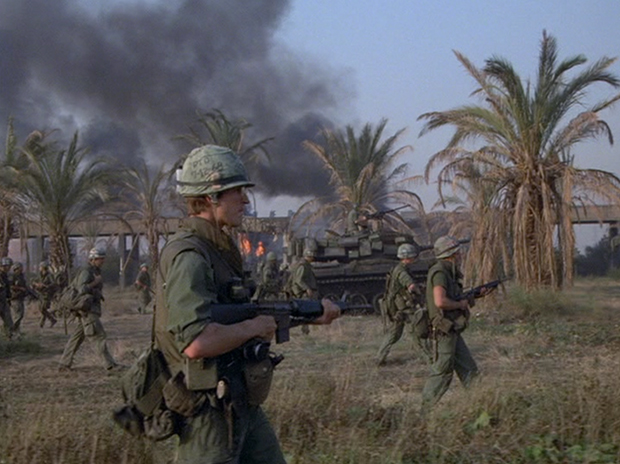
346 MS of Touchdown advancing toward the camera through palm fronds. (1:10:24)
347 MCU of Joker, Animal Mother beyond. (1:10:31)
348 MCU of Cowboy, Rafter Man beyond. (1:10:35)
349 MCU of Animal Mother. (1:10:39)
350 MLS of Animal Mother. (1:10:44)
351 MS of Joker, Rafter Man shooting photos beyond (1:10:49)
 346 |
 347 |
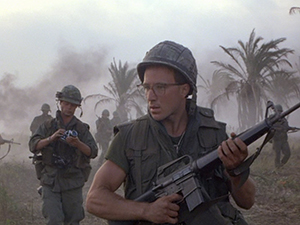 348 |
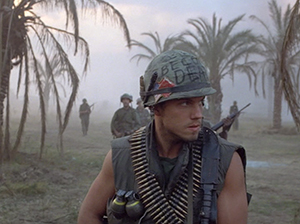 349 |
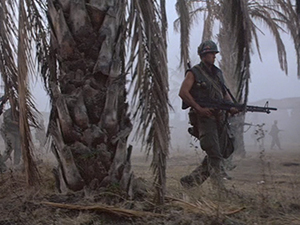 350 |
 351 |
352 Rear shot of Touchdown following a tank. Mortars hit in front of it. (1:10:55)
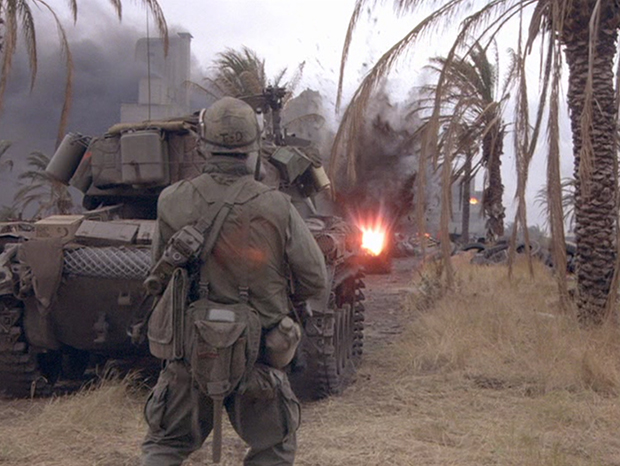
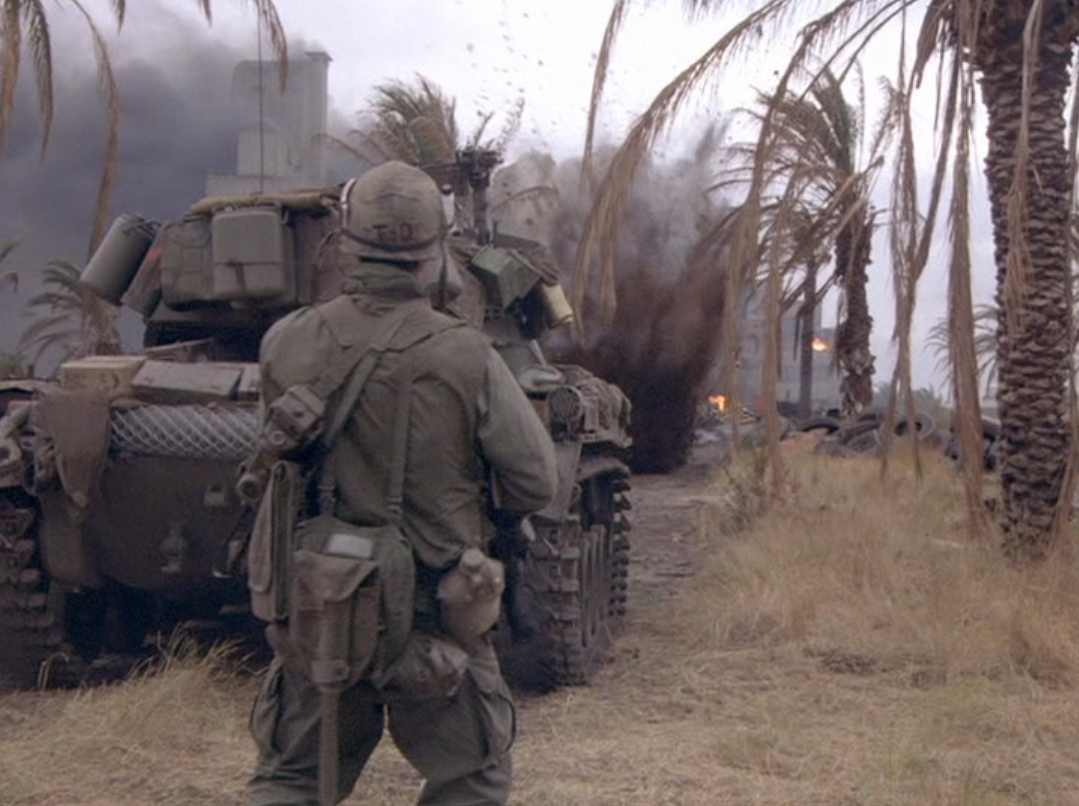
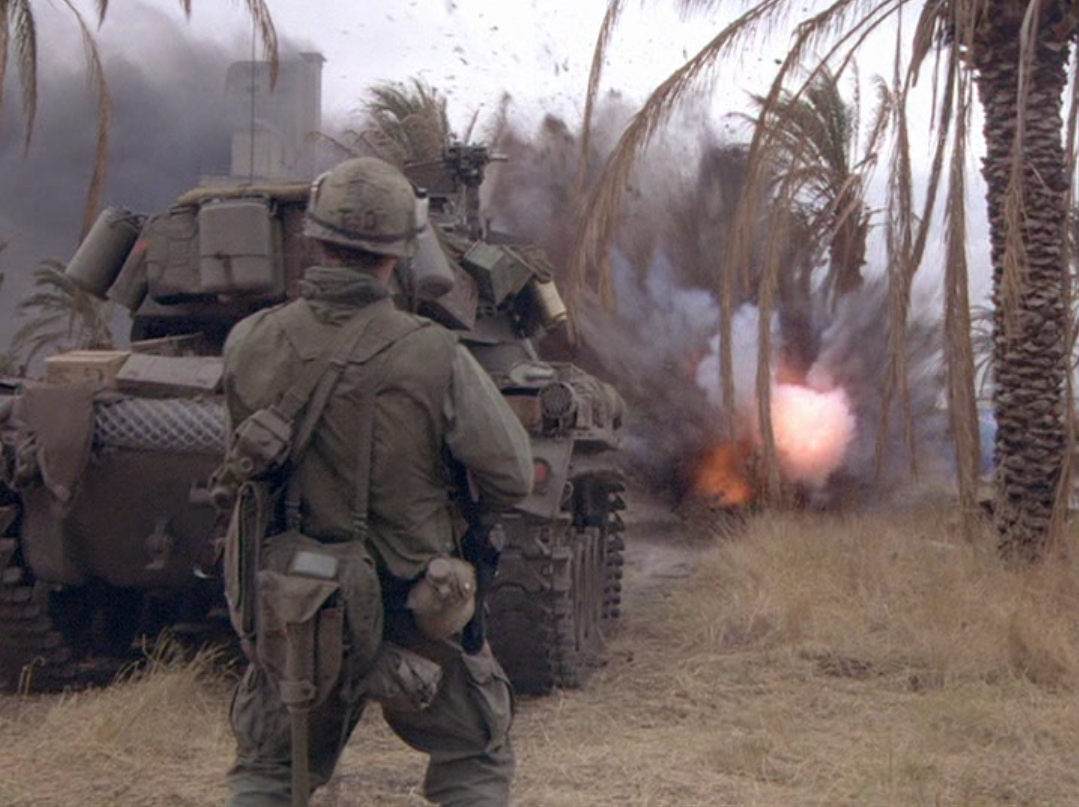
353 LS of the Marines following up the tank. At first Touchdown looks alright... (1:11:04)

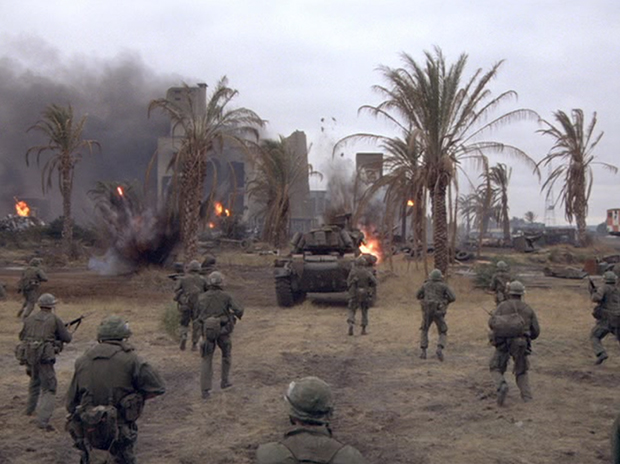
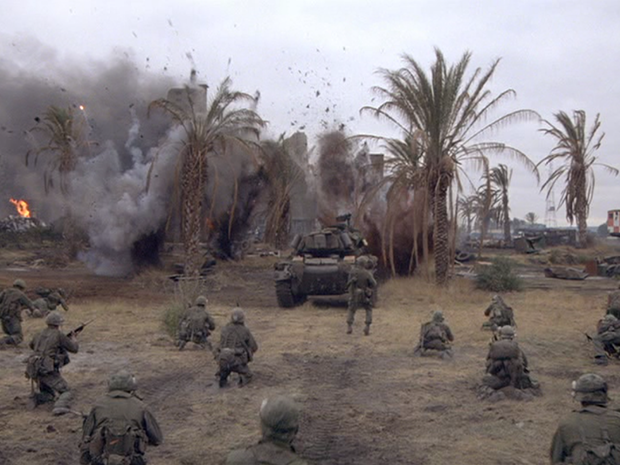
Kubrick has actually played with time here. We had seen the mortars hit at the end of shot 352 and there were 3 blasts, 1 a little ways before the tank, another immediately before the tank, and a 3rd viewed in the palm fronds. Shot. 353 opens with Touchdown still following the tank and we think briefly he may be okay, then the blasts in shot 352 are repeated, we have the first a little ways before the tank, the 2nd closer to it, and the 3rd viewed among the palm fronds, which is when both of Touchdown's knees buckle, as in shot 352.
All the men have thrown themselves to the ground, but for Touchdown, who remains standing a moment longer then falls on his back
354 CU of Cowboy looking up at the camera, feeling his nose. (1:11:10)
355 MS of Marines crawling over to Touchdown. (1:11:18)
MURPHY (checking Touchdown): Shit. (Makes a call.) Delta Six Actual, this is Murphy. Over. Delta Six Actual, this is Murphy. Over.
356 CU of Joker. (1:11:44)
MURPHY (off screen): Delta Six Actual, this is Murphy. Over. Delta Six Actual, this is Murphy. Over.
357 CU of Rafter Man. (1:11:46)
358 CU of Eightball. (1:11:50)
MAN [ON RADIO]: Delta Six.
359 CU of T.H.E. Rock. (1:11:51)
MURPHY (off screen): Delta Six, we are receiving incoming fire from the vill.
360 CU of Donlon. (1:11:54)
MURPHY (off screen): The lieutenant is down.
361 CU of Animal Mother. (1:11:57)
MURPHY: We're going to stop here and check out what's in front of us. Over.
362 MCU of Crazy Earl kneeling behind the tank. He rises and runs over to squat behind another one. (1:12:02)
CRAZY EARL: Okay, Lusthog Squad, listen up.
 354 |
 355 |
 356 |
 357 |
 358 |
 359 |
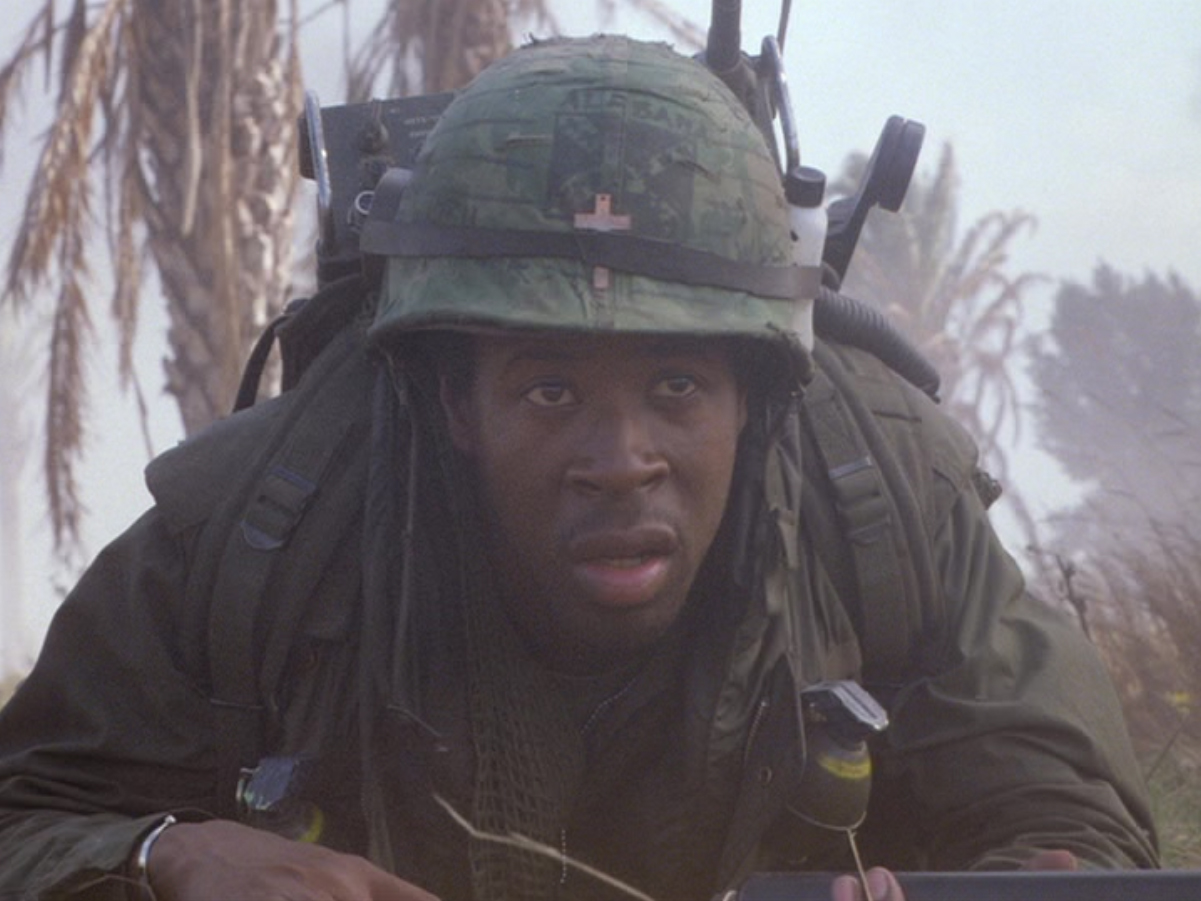 360 |
 361 |
 362 |
|
363 MLS of Crazy Earl kneeling behind the tank. We see in the background the same toothpaste ad as at Du Nang, and beyond it, more in the distance, a cigarette ad. (1:12:09)
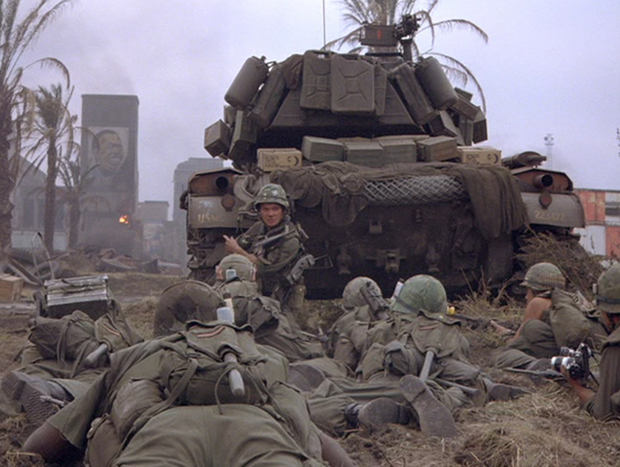
CRAZY EARL:
Gonna move up these two roads and check the vill. I want the third team up this road here. First and second fire team behind me up this other road, okay?
MARINES: Okay.
CRAZY EARL: Let's go. Let's get it done.
Everyone rises. They begin to move forward past the tank. Swiftly, by stages, they move closer to the building with the toothpaste ad. The camera low to the ground. A building with the sign "Leyna" begins to be seen.
364 Animal Mother and others with buses in background. (1:13:29)
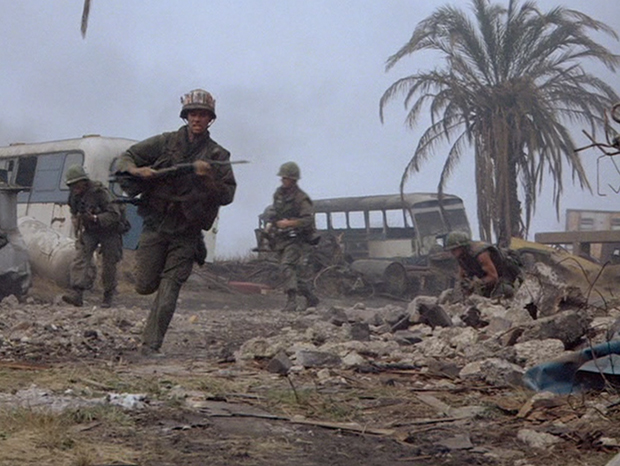
365 Footage which has a very shaky documentary feel of Marines running toward a burning building. We see Animal Mother among them. He hides behind a building with Hand Job. (1:13:30)
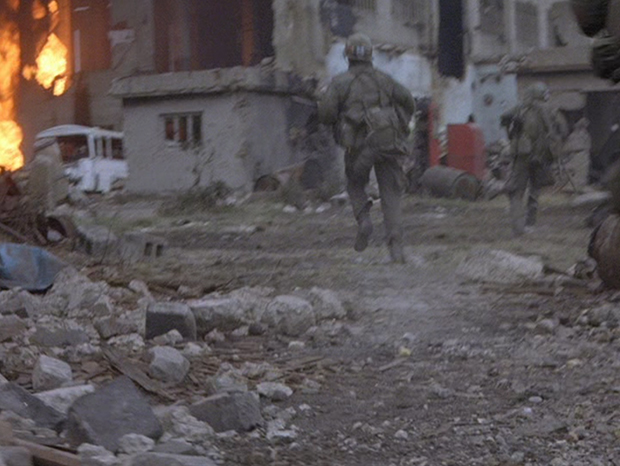
366 MCU Crazy Earl. (1:13:47)
367 The Leyna building. Shots are fired from it from the 2nd floor. Hand Job is struck and falls. (1:13:54)
368 MCU Animal Mother fires back. (1:14:01)
369 From behind Animal Mother. (1:14:03)
370 MS of Joker firing. (1:14:07)
371 Crazy Earl firing. (1:14:08)
372 From behind Cowboy, firing at the Leyna building. (1:14:10)
373 MCU of Cowboy firing. (1:14:14)
374 Animal Mother as in shot 368. (1:14:15)
375 Animal Mother as in shot 369. (1:14:18)
376 T.H.E. Rock fires a mortar. (1:14:21)
377 A window on the third floor of the Leyna building is blown out. Slow motion. (1:14:23)
378 Rafter Man takes photos, his hands shaking. (1:14:26)
379 Crazy Earl (1:14:29)
380 Animal Mother as in shot 377. The window on the 3rd floor of the Leyna building that was blown out in shot 377 is now intact and remains intact in following shots. I think we can ignore this discontinuity. (1:14:35)
381 Animal Mother from the front, MCU. Gun fire is abating. (1:14:40)
382 Crazy Earl. Gun fire ceases. (1:14:43)
383 Cowboy from the rear. Silence. (1:14:46)
384 MCU of Joker. Silence. (1:14:51)
385 MCU of Cowboy reloading his weapon. Silence. (1:14:54)
386 Crazy Earl. Silence. (1:14:57)
387 MCU Animal Mother. Silence. He slides out of view behind a wall. (1:15:02)
388 Crazy Earl. Silence. He drops a cartridge as he goes to reload his weapon. (1:15:08)
389 View from behind Crazy Earl. We see several likely NVA run before the cigarette ad building from right to left, away from the Leyna building. There's a gap, then a few more men run. Crazy Earl, who has reloaded his weapon, brings down the second few. (1:15:15)
390 MCU of Crazy Earl. "Surfin' Bird" begins to play. (1:15:28)
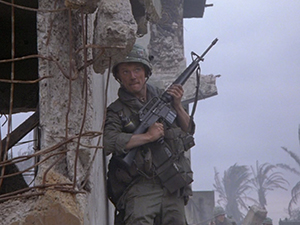 366 |
 367 |
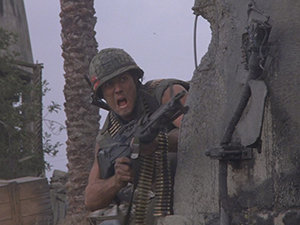 368 |
 369 |
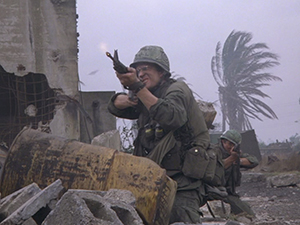 370 |
 371 |
 372 |
 373 |
 374 |
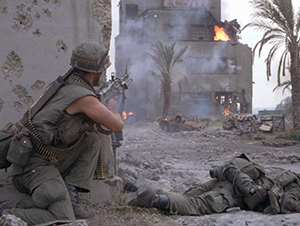 375 |
 376 |
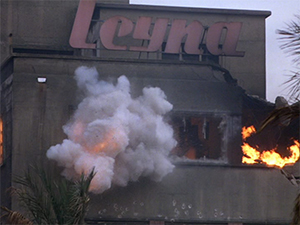 377 |
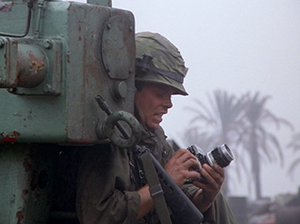 378 |
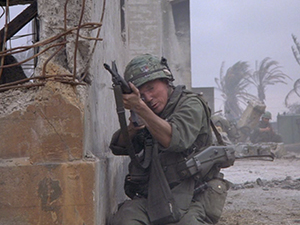 379 |
 380 |
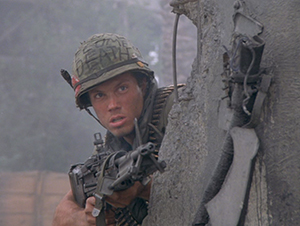 381 |
 382 |
 383 |
 384 |
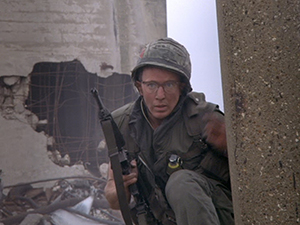 385 |
 386 |
 387 |
 388 |
 389 |
 390 |
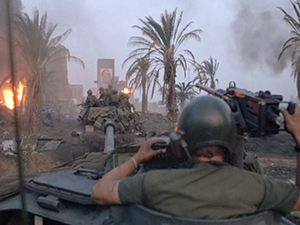 391 |
391 Rear shot of Marines on three tanks rolling in. (1:15:38)
Concerning Hue, "On Jan. 31, 1968, communist forces had taken control of Hue, the third largest city in South Vietnam. U.S. forces began their counterassault at daybreak on Feb. 15 as the Delta Company moved quietly through the maze-like alleyways and courtyards of the ancient Citadel. The oldest part of Hue, this fortification was built to protect the city when it served as the imperial capital of Vietnam." (Newseumed.org).
I have chosen the above brief description from Newseumed as it highlights the "maze-like" aspect of the Citadel, which I think would have been attractive to Kubrick, he having featured a maze in The Shining, and who would make a maze-like environment of Greenwich streets in New York in Eyes Wide Shut. Though the film's action never takes us inside the Citadel, the battle areas are filmed in such a way that they have a maze-like aspect to them, making it difficult for the viewer to establish their bearings. I'll discuss this more fully in Part Six, though I describe in notes below how we immediately disoriented with the killing of Touchdown.
The combat action of the film takes place during the Battle of Hue. The combat action of the book took place during the Battle of Hue and at Khe Sanh. Here is what I've cobbled from various sources on 1-5 and 2-5, relying on this USMCU lecture on The Battle of Hue City and 2nd Battalion, 5th Marines at Hue City, a Pocket History for movements of 2-5, and doing some major condensing:
2nd February, Hotel 2-5 drives into Hue under enemy fire and moves to the MACV (Military Assistance Command-Viet Nam) compound. Hotel, that night, relieves Golf that had taken the University building.
On the 3rd, Hotel seizes the public health building but must leave it during the night.
On the 4th, it seizes the public health building again.
On the 5th, the battalion seizes the Cercle Sportif Club and Hue University Library. The hospital is taken by the battalion.
On the 6th, Hotel company has taken the Provincial Headquarters, over which they raise the U.S. flag.
"In four days of vicious combat, 2/5 had broken the backs of two and possibly three NVA infantry battalions and an unknown number of VC units...Organized resistance south of the river was wiped out with an estimated 1053 enemy dead.
This was the end of Phase I. Phase II would be the fight for the Citadel...During 1/5's fight for the Citadel, 2/5 patrolled the South Side, mopping up scattered enemy resistance." (2nd Battalion, 5th Marines at Hue City)
Companies A, B, and C of 1-5 arrived 11th February at the Mang Ca (Citadel) compound, then began attacking on 13th February.
On February 13th, Hotel, with Fox, crossed the Phu Cam Canal to clear out the west side. "As Hotel moved west out of town, they were attacked by mortars. Caught in the open, Captain Christmas was hit by rocket fire. While he was being bandaged, more mortars hit his company. GySgt Thomas climbed on top of his skipper to protect him. Twenty-three Hotel Marines were hit, including all the officers, but two of the SNCOs. Lt . William Harvey, the battalion S-3A took command of the Hotel Company. (2nd Battalion, 5th Marines at Hue City)
On February 15th, D company of 1-5 captured Dong Ba Tower in a difficult battle against North Vietnamese soldiers in sniper foxholes in the tower, after which the tower was retaken by the North Vietnamese. It was recaptured on February 15th.
Company C, 1st Battalion, fought in Hue on 19 February 1968.
On the 22nd of February Company A staged a night attack that paved the way for a push forward on the 23rd and the Marines captured the southern wall of the Citadel.
24h of February, the Imperial Palace is captured and the South Vietnamese national colors are raised.
On the 26th of February they were relieved and joined with 2-5 to sweep east and north of the city.
During this time, on the 24th through 27th, 2-5 and others were involved in a large fight with the NVA, and on 2nd March Operation Hue City ended.
There are major differences between the book and the film on the sniper scenes, which I detail in Part Six, and won't get into them here. Though this battle has the men dealing with a sniper in the Leyna building it hasn't much, if anything, to do with the book with the exception of the death of Touchdown, who was Shortround in the novel.
The first sniper action in the novel occurs on the 24th of February. Cowboy describes to Joker, who was unconscious for part of it, how Hotel company raised the United States flag, "like on Iowa Jima", and his resentment at "poge officers" having them take it down and run up the Vietnamese flag.
The sun that rises in Hue on the morning of February 25, 1968, illuminates a dead city. United States Marines have liberated Hue to the ground. Here, in the heart of the ancient imperial capital of Viet Nam, a living shrine to the Vietnamese people on both sides, green Marines in the green machine have liberated a cherished past. Green Marines in the green machine have shot the bones of sacred ancestors. Wise, like Solomon, we have converted Hue into rubble in order to save it.
I'm unable to find anywhere with whom Hasford was attached at Hue, only that it is believed he was there, though it may have been only for a few days. It is believed he was present for Operation Pegasus in Khe Sanh.
The operation was initiated by 2nd Battalion, 1st Marines, 2nd Battalion, 2nd Marines, and three battalions from the Army’s 7th Cavalry and later joined by elements of the 5th, 9th, and 12th Cavalries, the 9th and 26th Marines, and an additional battalion of the 1st Marines (Prados and Stubbe 428-436). Hasford’s cousin Jason Aaron contends that Hasford was present for the Operation but does not detail what unit he was with. If Aaron’s contention is accurate, Hasford likely spent the Operation attached to one of the Marine Battalions I’ve listed as a roving reporter.
Source: "An Examination of the Life and Work of Gustav Hasford", a theses by Matthew Samuel Ross)
As Hasford's book placed them inside the Citadel for much of the action, which takes place at the end of the Battle of Hue, it would seem that for the film a choice was made to shift to 2-5, who were south of the Perfume River (Hue being divided by the Perfume RIver) in the early days of the Battle of Hue, the film giving us the impression this is when its combat action takes place.
I reason that Kubrick couldn't recreate the CItadel, so he couldn't stick with 1-5's action as described by Hasford. Nor could he recreate the well-known places where the 2-5 was recorded as being. Perhaps they were also in the industrial area of Hue? Kubrick shifts the battle to such areas.
I've read that a reason for plausibility in the film's recreation of the industrial environment was that Beckton Gasworks was "designed by the same French architects that did Hue's outer industrial areas" (Stanley Kubrick,: New York Jewish Intellectual), while Mythologizing the Vietnam War states, "In fact, it has been said that some of the buildings at Beckton were by the same French architects who had designed industrial buildings on the outskirts of Hue", and a Vanity Fair article by Michael Herr relates, "We were driving toward Beckton, an abandoned gasworks in the far East London, near the London docks. It was a late masterpiece of the 19th century Imperial Industrial Style, and Stanley had arranged to blow it up for his Vietnam film, let the pieces fall exactly where he wanted them to fall, even if it meant countermanding the laws of physics, and re-create Hue, which it already uncannily resembled, built about the same time as the industrial district of the Vietnamese city, and out of the same grand, doomed cultural assumptions." In a Guardian interview, Leon Vitali states, "We found Beckton Gasworks, which was constructed by the same company of French architects that built in the city of Hue, Vietnam."
I have been unable to find anything about French architects working on Beckton. All these buildings are concrete and rebar, this method of reinforced concrete construction having been pioneered in France, I read, about 1850, Joseph Monier receiving a patent for his technique in 1867.
Q. – Did you have a researcher on the film? N.P. – “For research, we only had about three or four books and they were on old China. That’s all we could find in England. But Stanley had a couple hundred black and white 8 x 10’s from the U.S. State Department and that was the bulk of our research. I was the only person in the art department who had actually been to Southeast Asia. We did have some good technical advisors because there were quite a few Vietnamese refugees in London at the time.”
N.P. – “Stanley wouldn’t let us have a Set Decorator. We had to do the buying ourselves over the weekends in our free time. When it became obvious that we weren’t going to be able to shop the entire movie from London markets, he let us send a buyer, Barbara Drake, out to Thailand for a few weeks, and she filled two shipping containers and sent them back to England. So that’s how low-tech the decorating process was.”
The Designer's Assistant interview with Production Designer Nigel Phelps
The most that I can find on any French architects being involved with Beckton, doesn't give them as involved with the planning, but in the mid-to-late 1800s, a visit was made to Paris to visit where their gas company was operating a large by-products works, and having officials of that company giving evidence to support the GLCC (Gas Light and Coke Company) establishing their own chemical by-products works.
In 1872, shortly before his retirement, Frederick Winsor Jnr, a Director of the GLCC, recommended that the company should establish its own autonomous chemical by-products works, because of the dislocation of the coal tar market by the Franco - Prussian war. Little account was taken of his suggestion at the time, but it arose again in 1877, the arguments in support of it being similar to those which had driven the construction of Beckton gas works: the consolidation of resources and an increase in the scale of production.
......
Before work began, three Directors of the GLCC: Evans, Bennoch and Chubb, paid a visit to Paris, where the city’s gas company was operating a large by-products works. Because parliamentary powers were required before a major project like the construction of Beckton Products Works could go ahead, officials of the Paris company agreed to come to London to give evidence to support the GLCC. The necessary authority was duly obtained and J G Lyon, who was employed specifically for that purpose, prepared the initial plans of the works. He also undertook to supervise operations at the works for the first six months of its existence. Some measure of expenditure was also agreed upon.
Source: Chemicals from Coal, A History of the Beckton Products Works, Cyril Arthur Thownsend, 2003
J. G. Lyon, who was British, is credited with the initial plans.
I can find nothing specific about architects involved with Beckton's industrial architecture circa 1930s and later which is what we predominately seem to view in the film.
Instead, the Complete Stanley Kubrick Exhibit at LACMA relates that, "With the help of production designer Anton Furst, Kubrick created the city of Da Nang and the bomb rubble of Hue on one square mile at Beckton, in east London, at an old gas works scheduled for demolition. Research showed that the French-styled industrial architecture of Hue resembled the buildings at the gas works."
There's no mention at the exhibit of Beckton and Hue sharing French architects. Instead, the industrial architecture at Beckton resembled the "French-styled" industrial architecture in Hue, which might simply mean that under the period of French colonialism such environments in Hue were designed either by French architects or under their influence.
Under French Colonialsm for many years, Vietnam and Hue are filled with examples of French Colonial architecture, then as the French Colonial period ended the Vietnamese made interesting moves into mid-century modern.
The reason I'm interested in the insistence that Beckton was designed by French architects, the same who designed Hue, is that we've the following from Gustav's novel.
We see the great walls of the Citadel. With zigzagging ramparts thirty feet high and eight feet thick, surrounded by a moat, the fortress looks like an ancient castle from a fairy tale about dragons who guard treasure and knights on white horses and princesses in need of assistance. The castle is black stone against a cold gray sky, with dark towers populated by shadows that are alive.
The Citadel is actually a small walled city constructed by French engineers as protection for the home of Gia Long, Emperor of the Annamese Empire. When Hue was the Imperial Capital, the Citadel protected the Emperor and the royal family and the ancient treasure of the Forbidden City from pirates raiding from the South China Sea.
The Imperial Citadel of Hue, built in 1805, was designed by French architects with a mind for fortification. And I believe that Kubrick conceived of the scene with the female sniper of giving hints of the Palace of Perfect Peace in the Forbidden City. And it seems to me that it was somehow important to make a connection between it and Beckton.
Kubrick does the same thing in shots 352 and 353, that he did in shots 218 and 219 when Rafter Man's camera was stolen in Da Nang at the bar beside the Las Vegas establishment.
In shot 217 we had observed the man who would steal the camera approaching then grabbing the camera. In shot 218 Kubrick had pulled back to along shot from behind Joker and the prostitute, the thief already with the camera in hand running past them into the street and out of the right frame of the film camera. Joker and the prostitute turn in surprise to stare after him. Then in shot 219, Kubrick drops back a bit in time. We view the thief from the side, he having just grabbed the camera, and he is running past Joker and the prostitute who have not yet had time to really react to the theft. The camera turns to show him running into the street, where he tosses the camera to his accomplice who is waiting on a motorbike.
As the Marines approach this complex of buildings in Hue, men on foot following behind a tanker, in shot 352 we see the suspence of their anticipation of battle erupted by mortars/shells hitting before the tank, three in quick succession, the third one viewed through the palm fronds of a tree. The way that Touchdown rises up slightly, his knees bent, we can tell that he has been hit. Then in shot 353 Kubrick drops back for a long shot of the scene, of the buildings, the tank, Touchdown, and the men behind him. Touchdown's feet are flat on the ground, he hasn't fallen, and at first we think he might be safe after all. But then we realize that we have also dropped back in time as the 3 mortars/shells strike again (other shelling occurs but I'm concerned only with those 3 in front of the tank). Touchdown rises on the tips of his feet, his knees bent, as the rest of the men drop down to the ground. He stays standing a moment longer, then drops to the ground on his back. We see in the distance the face of Brother Seven Cha, from the Hynos toothpaste ad, staring over the scene. The face of Brother Seven Cha is almost entirely dissociated from the Hynos toothpaste connection as the bottom of the giant ad has been partly torn away, but in closer shots we see at the bottom the toothpaste tube sticking out of the remaining left portion of the box on which is also displayed Brother Seven Cha's face in miniature.
We have been returned to shot 225 in which Brother Seven Cha, in Da Nang, by means of a crossfade, smiles over the tanks at the Marine installation in Da Nang, that crossfade having anticipated the tanks riding into Hue.
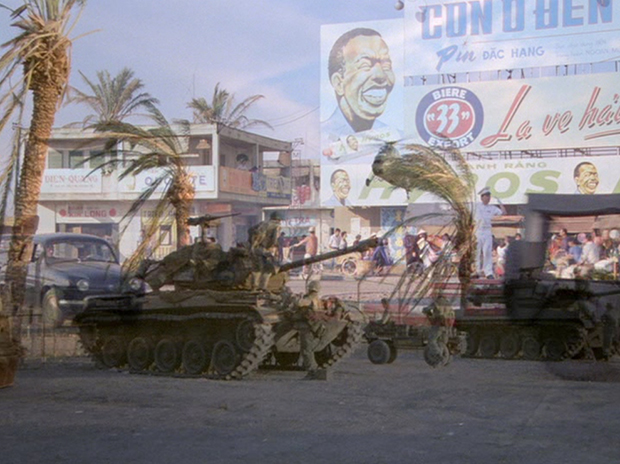

This first battle scene is about six minutes long, so it's not lengthy, but it feels long and a reason it does is because how battles are typically framed in war films. They are built around stories and the action transpiring during the battles furthers a plot that usually is an umbrella for several sub-plots. Characters are built and relationships are explored in service of the plot. Little building block stories are all directed toward the eventual climax of a structured big story and they typically, sensibly fit together. This shape is retained in the boot camp section of the film, but afterward it can feel like we are swimming aimlessly, just keeping our heads above water. Bullets are fired. People run through wreckage. People take cover. Where are the bullets coming from? Close-ups and medium close-ups of the individual Marines make it near impossible to fix their positions in relationship to one another and enemy fire. One pile of concrete rubble or a blasted concrete and rebar wall can look very similar to another pile of concrete rubble or a blasted concrete and rebar wall.
The battle scene also may feel long because Kubrick throws our bearings out the window at the very beginning so we scramble throughout trying to understand where everyone is positioned, even though we have the big landmarks of Brother Seven Cha, and Leyna staring down at us.
Leyna happened to be the name of another toothpaste, only it's not pictured, so we see the face of one toothpaste staring down at us, and don't know the name of a rival toothpaste is also another landmark in this scene. I've no idea what Hynos means, I don't think anyone does, but Leyna may or may not mean "light" or "bright", a variation on Helen, and may fit in with the light that becomes of significance in the scene in which Pyle kills Hartman and commits suicide.
First, we are given, in shot 353, a long view of the scene, as Touchdown is killed, and we believe this establishes the landscape for us.
After Murphy is felled, after the long shot, we are briefly shown Cowboy. Then we are shown, below, in shot 355, a Marine checking on Touchdown, and Murphy getting on the tank's wireless. Thereafter, in shots 356 through 361, as we hear Murphy speak, we are shown the Marines individually. The camera faces their faces, away from the city, in close-up. Because of this we have no idea of where they are in proximity to one another. We know they are behind the tank, that's all. We had been shown the Marines following the tank in the long shot.
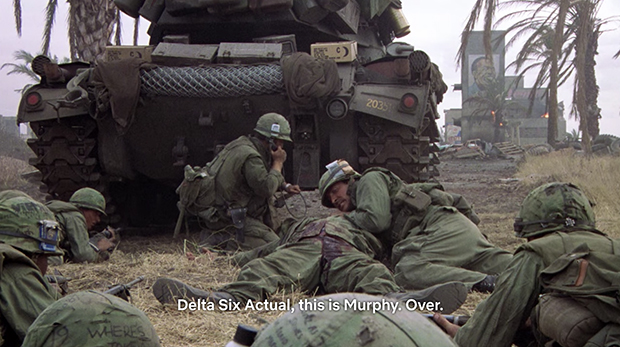
Suddenly in shot 362 we are back behind the tank where we see only Crazy Earl. We're not shown Touchdown, we're not shown the Marine checking on him. We're not shown Murphy. We just see Crazy Earl. Though we heard Murphy talking on the wireless, and know from from his helmet he isn't Crazy Earl, we may even be given the feeling that Crazy Earl had been the one on the wireless. After all, we are immediately shown Crazy Earl behind the tank after we hear Murphy in a voice-over in shot 261 saying, "We're going to stop here and check out what's in front of us." It's natural that we make an association between Crazy Earl and that voice on the wireless.
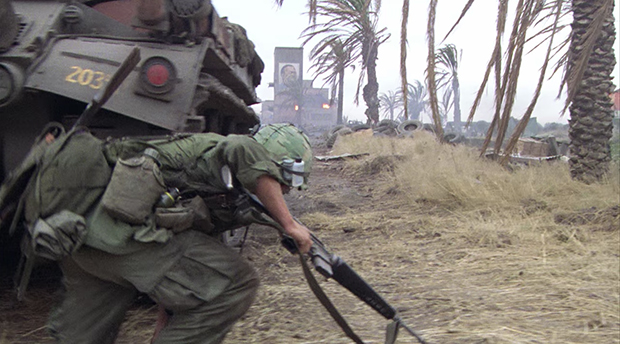
Crazy Earl runs to screen right...
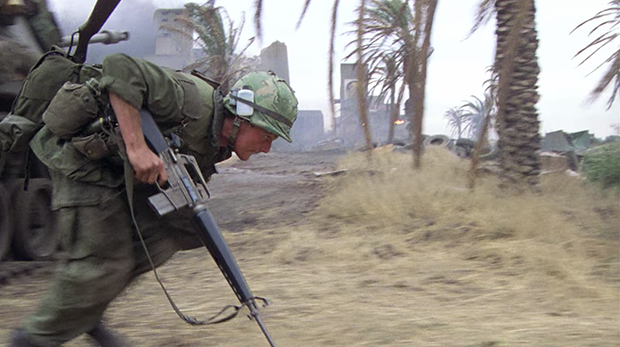
Crazy Earl continues to run to screen right to another tank behind which the Lusthogs are clustered.
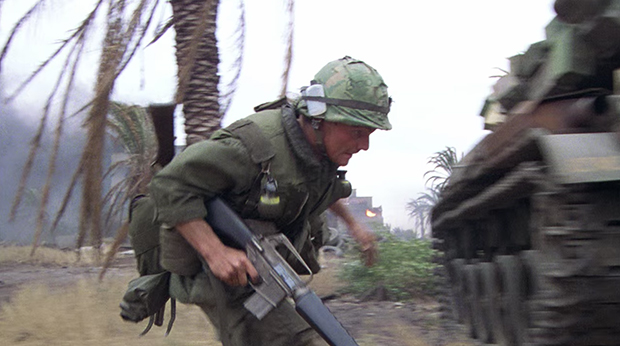
This tank was not initially there. Check the full landscape screengrab above of shot 353. There's no second tank before that green bush to the right of the palm tree that's screen right of the tank behind which Touchdown was felled. And we can be confident it didn't drive up in the interim, while Murphy was on the phone.
Tank 203511 was the one behind which Touchdown had been walking. We are not shown tank 203511 again after Earl has crossed over to tank 223472. This means we never see these two tanks at the same time. That plays with how we comprehend things...or don't...because we have now two mind maps of things and they exist as both blended and split. We have seen Crazy Earl cross over to another tank and we have that mind map. We also have the mind map of the landscape with the one tank, only that one, and even though Crazy Earl crossed to another tank, that mind map still exists. If we had been shown Crazy Earl beside Touchdown behind that first tank, and seen in that same shot Crazy Earl crossing over to the second tank, despite the second tank not having been there formerly we would have a sense of concrete separation. But that didn't happen. That's what I mean when I say the two environments are both separate but blended, even though Brother Seven Cha was looking down at us from the right of the first tank and now is looking down at us from the screen-left of the second tank.
In shot 363, the men rise and all run into the city. It is a long shot, about a minute and 20 seconds before we cut to another.
Another nice bit of disorientation. Below, in shot 363, we see Joker leaning against the yellow-orange vehicle, and we see Animal Mother up ahead, with the bare arms, having just crouched down. Another Marine is passing to Animal Mother screen-right.
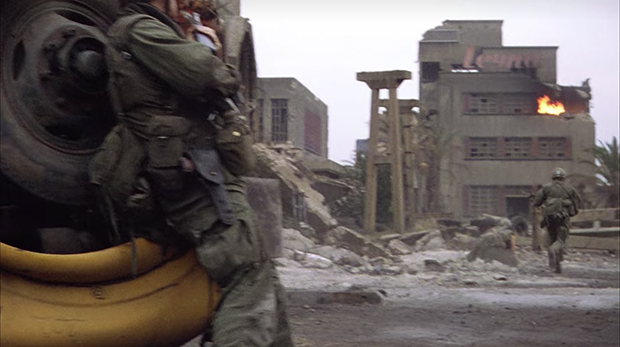
Still in shot 363, a Marine (we don't see who it is) comes running up from behind Joker and the camera follows him.
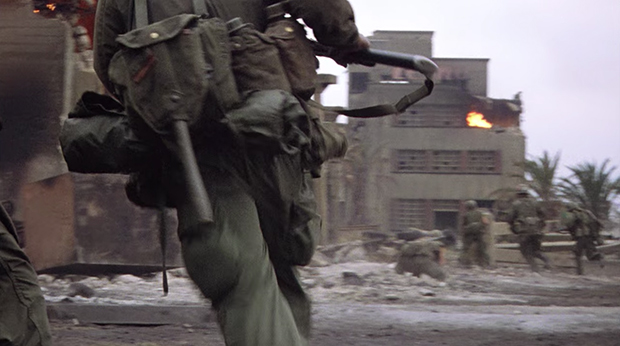
The momentum and flow of the camera following behind the runner in the prior shot, makes us feel we are now ahead of him and looking at him in shot 364 below, and we see Animal Mother on the right, still crouching, but what are we seeing in the background? Where did those buses come from? Actually we have turned about 90 degrees so we are looking to what was screen right, previously out of frame (or only dimly observed on the periphery), and the man running toward us was not the man the camera was following in the prior shot but was up in front of Animal Mother. That is really artful that the sense of momentum alone transfers us so easily from one individual to another, confusing identities and sense of place. The person running toward us is actually Hand Job.
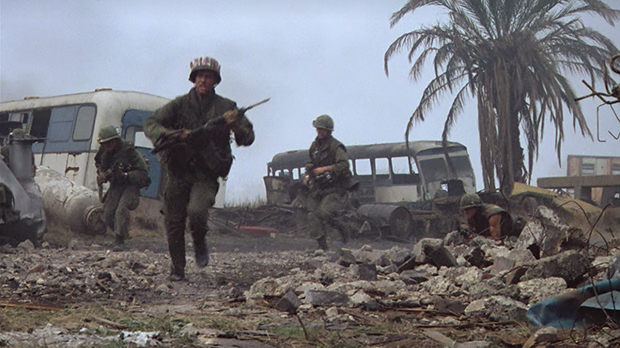
Animal Mother's position in the battle is easy to find. Returning to shot 363, while everyone was running forward, we were briefly given a glimpse of a low one story building to the left of the slab of wall on which is the Brother Seven Cha (the ad now out of frame).
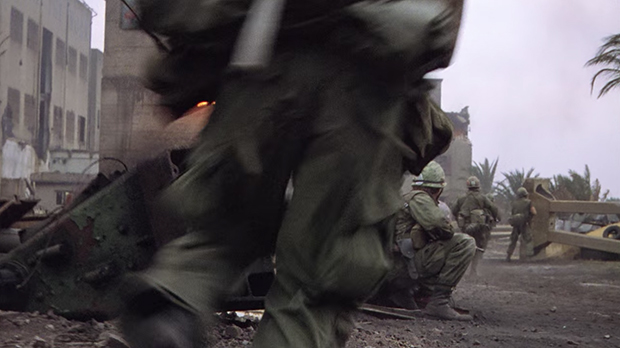
When, in shot 364, in which the 90 degree angle turn and reverse has been made, Animal Mother runs toward the camera, which is toward what was originally screen left of Brother Seven Cha. In shot 365 we see him run up to the building we briefly observed in shot 363, where Hand Job already has taken cover. Animal Mother will remain here for the duration of the battle.
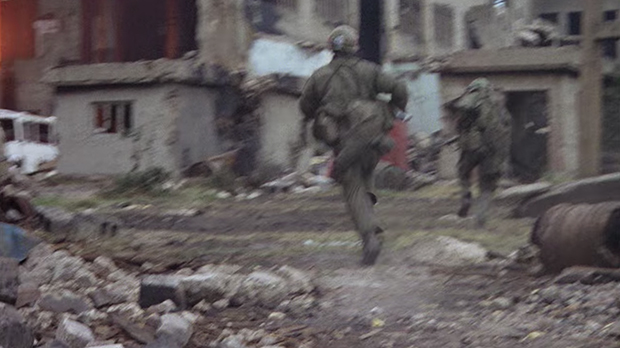
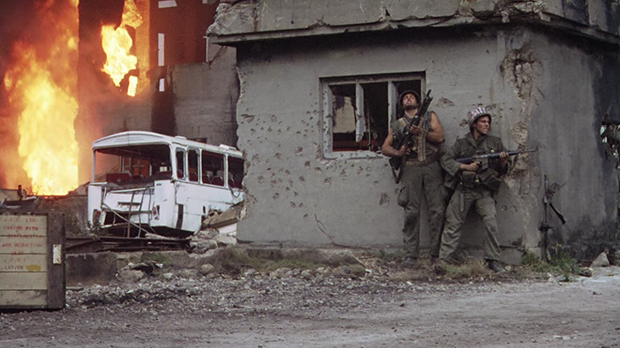
The below screengrab is from shot 363 and gives us a view down the road between Brother Seven Cha and the Leyna building. We see, in the distance, the Cotab cigarette ad.
The below screengrab is from shot 363 and gives us another view down the road toward the left of the Leyna building.
We have seen another low building to screen right of the one behind which Animal Mother has taken cover with Hand Job. When Hand Job is killed we see briefly the leg of another person concealed next to that neighboring building on the right.
Crazy Earl looks like he's taken cover next to a blown apart structure directly in front of the Leyna building, but I can't begin to tell where that structure is unless it is the building to screen right of where Animal Mother is hiding.
Every time I see that Cotab cigarette ad I think of the Drome ad for cigarettes in Lolita and the complexity of it, how it ends up tying in with what turns out to be Bombing Range Road in South Dakota, which connects in with Dr. Strangelove.
Crazy Earl is killed during the first combat/sniper incident in the book, going crazy and running out with his BB gun to fire at a machine gunner. Here, he's lucky he isn't killed, dropping his cartridge and having to search for it as four NVA run screen left from the Leyna building, followed by two others who he shoots. For a moment he was fully exposed and helpless with his rifle not armed. I read on one Marines forum an individual complaining about how Crazy Earl didn't go after the other four NVA before sitting back and congratulating himself for his two kills. But the same question could be posed as to everyone else in the Company, as no one else shot at the first or second group of NVA runners and we hear no one else pursuing them.
Just noting that shot 365 is distinctly different in feel from the rest of the footage. It communicates the feel of lower-tech documentary filmmaking, a camera person capturing footage while they run with a hand-held camera. To me it's an interesting nod, perhaps, to all the documentaries that Kubrick had viewed when preparing to film Full Metal Jacket because otherwise his style is cinematic big screen Kubrick, nothing about it is newsreel or indie. I don't know if he imagined this shot would, backwards and forwards, permeate the surrounding footage.
As soon as we 're done with this combat section, Kubrick brings in the visiting filmmakers, so I believe shot 365 has to do with this, though they're not yet viewed, we don't see them on the ground--but then we don't see the indie filmmakers in documentaries on Vietnam because they're filming. Kubrick seems to be introducing the filmmakers through their aspect of invisibility and yet they are the recording witnesses who guide how what is witnessed is viewed. I'll discuss this more in the next section.
Exempting the death of Touchdown (Shortround), this battle isn't portrayed in the book, but is certainly intended to take the place of the first sniper incident in the novel, described to Joker by Cowboy, after which Shortround (Touchdown) had been fragged by Animal Mother.
Approx 11, 800 words or about 24 single-spaced pages.
Next: Full Metal Jacket Analysis - Part 5
Go to Table of Contents for Analysis of "Full Metal Jacket"
Link to the main TOC page for all the analyses